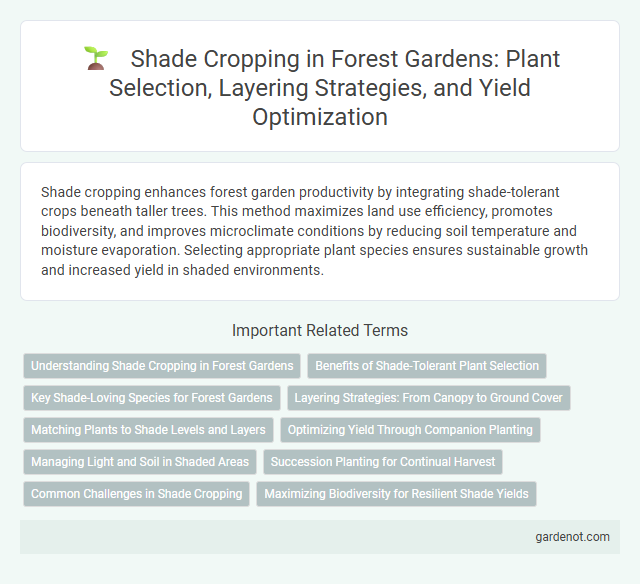Shade cropping enhances forest garden productivity by integrating shade-tolerant crops beneath taller trees. This method maximizes land use efficiency, promotes biodiversity, and improves microclimate conditions by reducing soil temperature and moisture evaporation. Selecting appropriate plant species ensures sustainable growth and increased yield in shaded environments.
Understanding Shade Cropping in Forest Gardens
Shade cropping in forest gardens involves cultivating shade-tolerant plants beneath taller tree canopies to maximize space and biodiversity. This method enhances microclimatic conditions, reduces soil erosion, and improves nutrient cycling by mimicking natural forest ecosystems. Integrating shade crops like coffee, ginseng, or ferns supports sustainable yields and resilient agroforestry systems.
Benefits of Shade-Tolerant Plant Selection
Selecting shade-tolerant plants in forest gardens enhances biodiversity by supporting understory growth and improving habitat complexity. Shade cropping reduces soil erosion and retains moisture, promoting healthier root systems and increasing overall plant resilience. These benefits optimize land use efficiency while fostering sustainable agricultural ecosystems.
Key Shade-Loving Species for Forest Gardens
Key shade-loving species for forest gardens include American ginseng, wild ginger, and Solomon's seal, which thrive under dense canopy cover. These plants contribute to biodiversity by occupying lower light niches and enhancing soil health through their root systems. Incorporating shade-tolerant crops promotes sustainable forest garden ecosystems by optimizing vertical space and nutrient cycling.
Layering Strategies: From Canopy to Ground Cover
Shade cropping in forest gardens employs strategic layering to optimize plant growth, starting from tall canopy trees like walnut or chestnut that provide filtered sunlight. Understory layers incorporate shade-tolerant shrubs and smaller fruit trees such as hazelnuts or blueberries, which thrive in partial shade. Ground cover plants like wild ginger or ferns protect soil moisture, suppress weeds, and contribute to nutrient cycling, creating a resilient and productive multi-layered ecosystem.
Matching Plants to Shade Levels and Layers
Shade cropping in forest gardens requires selecting plant species that thrive under specific light conditions found within different canopy layers. Matching plants such as shade-tolerant ferns, wild ginger, and certain mushroom varieties to lower light levels enhances biodiversity and maximizes space efficiency. Understanding the vertical stratification, from emergent trees to herbaceous ground covers, ensures optimal growth and yields in a sustainable agroforestry system.
Optimizing Yield Through Companion Planting
Shade cropping enhances forest garden productivity by strategically pairing shade-tolerant plants with taller, sun-loving species to maximize space and resources. Companion planting optimizes microclimates, reduces pest pressure, and improves soil health, resulting in higher overall yields. Selecting compatible species such as shade-tolerant herbs beneath fruit trees ensures efficient light utilization and sustainable growth.
Managing Light and Soil in Shaded Areas
Shade cropping in forest gardens involves strategically selecting plant species that thrive under low light conditions to optimize photosynthesis and maintain soil health. Managing light includes pruning trees to allow dappled sunlight, enhancing understorey growth and biodiversity. Soil management focuses on maintaining moisture and nutrient levels through organic mulches and nitrogen-fixing plants to support robust plant development.
Succession Planting for Continual Harvest
Shade cropping in forest gardens leverages succession planting techniques to ensure continual harvest by strategically layering shade-tolerant crops beneath taller canopy species. This method optimizes light utilization through seasonal and spatial crop variation, promoting sustainable productivity in shaded environments. Selecting compatible species with staggered maturity periods enhances yield stability and soil health over time.
Common Challenges in Shade Cropping
Shade cropping in forest gardens often faces challenges such as reduced sunlight availability, which limits photosynthesis and crop yield. Managing competition for water and nutrients between shade-tolerant crops and overstory trees requires precise planning and soil management. Pest and disease control becomes more complex due to the humid microclimate created by dense canopy cover, necessitating integrated pest management strategies.
Maximizing Biodiversity for Resilient Shade Yields
Shade cropping in forest gardens enhances biodiversity by integrating diverse plant species that thrive under canopy shade, promoting ecosystem resilience and stability. Maximizing biodiversity in these systems supports natural pest control, improves soil health, and ensures consistent yields despite environmental fluctuations. Incorporating nitrogen-fixing shrubs, shade-tolerant fruit trees, and understory herbs creates a multilayered habitat that sustains productivity and adapts to changing climate conditions.
Shade cropping Infographic

 gardenot.com
gardenot.com